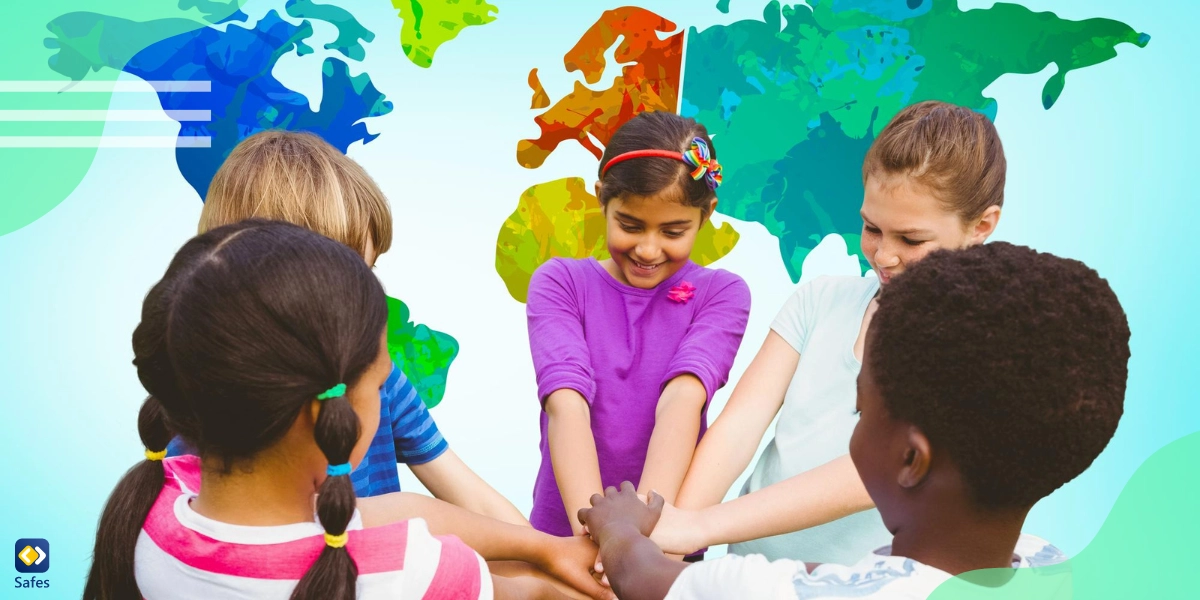“Cultural awareness” is not just another buzzword in today’s increasingly globalized world. It is a crucial skill that children need to thrive in diverse societies and workplaces. Cultural awareness means understanding and appreciating different cultures’ values, traditions, and social norms and being sensitive to cultural differences. In this guide, we will discuss various strategies for teaching children about cultural diversity and how to nurture cultural awareness from an early age.
Download and Start Your Free Trial of the Safes Parental Control App
What Is Cultural Sensitivity?
Cultural sensitivity, or cultural competence, is the ability to interact effectively with people of different cultural backgrounds. It requires understanding and respecting cultural differences and being aware of one’s own cultural biases. Cultural sensitivity is crucial in today’s globalized world, where children will inevitably interact with people from diverse cultures in school, at work, and in their communities.
Cultural sensitivity requires adjusting one’s behavior and attitudes to respect those differences. We all need to learn about different cultures, be open to different perspectives, and challenge our own biases.
What’s the Benefit of Cultural Awareness?
Unfortunately, some people don’t realize the benefits of cultural differences. “Cultural biases occur when our brains take a shortcut to interpret another culture from the viewpoint of our own,” explains Karyen Chai, Communications Chair at the Singapore Psychological Society. Meanwhile, it helps to know that many of the advances made throughout history were because of cultural differences. Isolated countries saw little advancement, while those at the hub of communication with communities from various cultural backgrounds thrived. “Cultural diversity is a driving force of development, not only with respect to economic growth but also as a means of leading a more fulfilling intellectual, emotional, moral and spiritual life,” explain the United Nations in their article for the World Day for Cultural Diversity for Dialogue and Development,
Cultural diversity brings so many benefits because each individual brings varied beliefs, opinions, experiences, knowledge, language, and many other things that are new and unprecedented to others. But bigotry and discrimination just filter out these novelties, labeling them as dangerous to their preexisting ideas and lifestyle. Not everything new is valuable and deserves respect; that’s also a fact. But the point is to handpick whatever helps you grow both materialistically and spiritually. Culturally sensitive children can benefit from all that.

Start Early: Nurturing Cultural Awareness in Infants and Toddlers
Cultural awareness can benefit a person in all stages of their life, so it’s best to teach your child from an early age. Children start to notice cultural and racial differences from a very young age. Toddlers and preschoolers are naturally curious about the world and often ask questions about why people look or act differently. It is an excellent opportunity to start teaching them about cultural diversity.
You can introduce cultural diversity through age-appropriate books, toys, and games. Books that feature characters from diverse cultures can help children understand that people from different cultures can have different traditions, foods, and ways of dressing but are still fundamentally the same.
You should also try to expose your child to diverse environments where they can interact with people from different cultures. You and your family can attend cultural festivals, visit museums, or even travel to other countries to get to know varied cultures.
Embracing Cultural Celebrations and Traditions
Celebrating cultural holidays and traditions is a fun and engaging way to teach your child about different cultures. Together, you can cook traditional foods, learn about cultural customs and rituals, and participate in cultural celebrations.
You can use these celebrations to teach your child about the history and significance of traditions, which helps them understand their cultural context and build a sense of respect and appreciation for different cultures.
Diverse Reading: The Power of Multicultural Literature
Use multicultural literature to teach your child about cultural diversity. Books with characters from different cultures help your child understand and appreciate cultural differences. They can also help children see the world from different perspectives, fostering empathy and understanding.
You can choose books written by authors from diverse cultural backgrounds, as these books often provide authentic representations of their cultures. It’s also important to choose books that portray cultural diversity positively and realistically rather than relying on stereotypes.
Use the Power of Cinema to Build Cultural Awareness
Cinema is an excellent medium for teaching cultural awareness to your child. Movies made by filmmakers from different parts of the world, or those that focus on a specific culture, are fabulous for your child’s development.
Take the feature animation Coco (2017) as an example. It features a Hispanic child named Miguel who is transported to the Land of the Dead, where with the help of his deceased great-great-grandfather, he tries to return back home and persuade his parents to let him play music. This movie hits many targets all at once. Not only it teaches children about Latin American music but also the famous Mexican festival Día de Muertos (Day of the Dead). It also helps children confront the issue of death in a child-friendly way.

Find out more movies for children that are fun to watch while also helping your child’s development on Safes: Discover the Magic of Movies About Child Development with Your Kid!
Travel as a Cultural Learning Experience
Traveling to other countries can be a transformative experience for your child because it exposes them to different cultures, languages, and ways of life, broadening their horizons.
While traveling, encourage your child to interact with local people, try local foods, and learn about local traditions and customs. Such activities can help your little one understand that while people from different cultures may have different ways of life, they are still fundamentally the same.
Teach Empathy Through Perspective-Taking
Help your child see the world from different perspectives by teaching them how people from different cultures may think, feel, and view it.
You can support perspective-taking by encouraging your child to imagine how they would feel if they were in someone else’s shoes. Discuss different scenarios, such as how it might feel to move to a new country and not speak the language or how it might feel to be treated differently because of one’s cultural background.
Discussing Stereotypes and Prejudice
As children grow older, they will inevitably encounter stereotypes and prejudice. You can use these instances as teachable moments, helping your child understand why these stereotypes are harmful and unfair.
You can also teach your child the importance of challenging stereotypes and standing up against prejudice. You can achieve that by discussing how stereotypes can lead to discrimination and how everyone is responsible for treating others with respect and fairness.
Fostering Inclusive Friendships
Fostering friendships with people from different cultures can help your child develop a genuine appreciation for cultural diversity. These friendships can expose children to different perspectives and experiences. They can help challenge any stereotypes or biases they may have.
You can encourage inclusive friendships by exposing your child to diverse environments and by creating a home environment that is welcoming and accepting of people from all cultures.
The Role of Technology and Parental Control Apps
Today’s children can use social media and other online platforms to get information about different cultures and interact with people worldwide. However, the platforms’ ease of access and vastness also means a child may be exposed to biased or derogatory content about different cultures. Unfortunately, it’s easy for children to stumble upon racist or bigoted opinions on social media and other platforms. But thankfully, you can mitigate the effect of these platforms with parental control apps like Safes.
Safes can help you monitor and manage your child’s online activities, exposing them to positive and respectful representations of different cultures. One way Safes achieves that is by keeping you in the loop with your child’s activity on social media. If your child comes across inappropriate content or receives a harmful message, you’d be notified, allowing you to intervene before it becomes a problem. Safes also enables you to block dangerous apps, websites, and even search keywords, which gives you peace of mind that these harmful sources won’t threaten your dear one.
Feel free to download Safes on Google Play and App Store or our website. Make sure you read these pages to learn how to set up parental controls on different platforms:
Why not start with a 14-day free trial of Safes? It’s a great way to discover how Safes can help you manage your child’s online safety without any initial payment.
Leading by Example: Parental Cultural Sensitivity
You play a crucial role in shaping your child’s attitudes toward cultural diversity. No parental control can be effective as long as you, the father or mother of your child, don’t serve your child as a positive example. Children often model their behaviors and attitudes after their parents. Hence, you need to demonstrate cultural sensitivity in your everyday interactions.
So, be a true role model for your child by respecting different cultures, challenging stereotypes, and being open to other perspectives.
Conclusion: Cultural Awareness and Sensitivity in Children
Teaching your child about cultural awareness and sensitivity is not easy, but it is crucial. In today’s increasingly diverse society, your child must have the skills to understand and appreciate cultural differences and interact effectively with people from different cultures.
By starting early, embracing cultural celebrations, exposing your child to diverse reading materials or movies, and leading them by example, you can build a lifelong appreciation for cultural diversity in your child. And with the help of technology and parental control apps like Safes, you can ensure that your loved one is exposed to positive and respectful representations of different cultures.
With patience, persistence, and genuine respect for cultural diversity, you can help your child become culturally aware and sensitive individuals ready to thrive in our diverse world.
Your Child’s Online Safety Starts Here
Every parent today needs a solution to manage screen time and keep their child safe online.
Without the right tools, digital risks and excessive screen time can impact children's well-being. Safes helps parents set healthy boundaries, monitor activity, and protect kids from online dangers—all with an easy-to-use app.
Take control of your child’s digital world. Learn more about Safes or download the app to start your free trial today!



